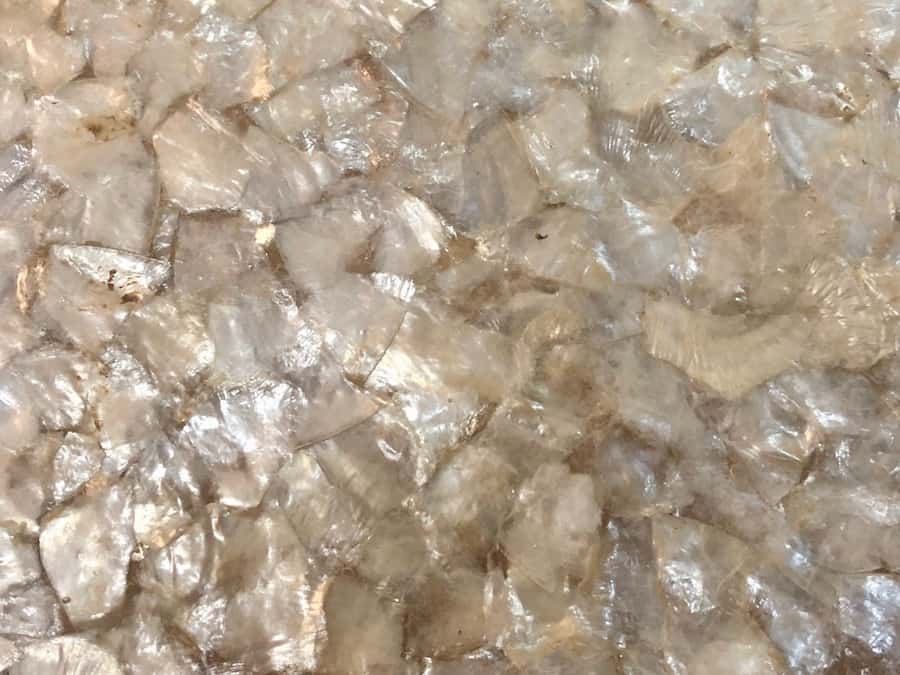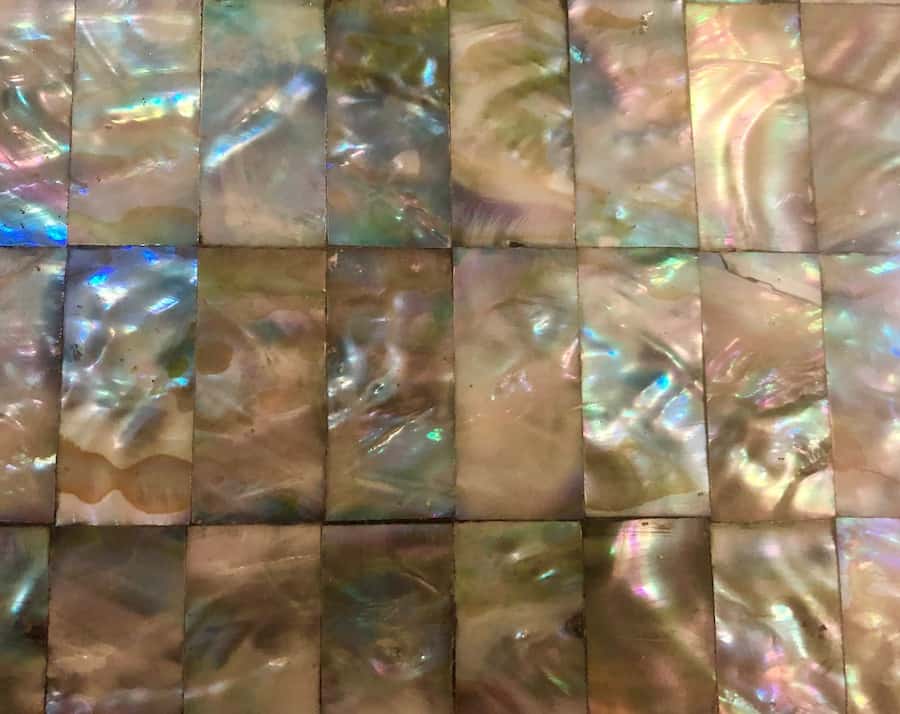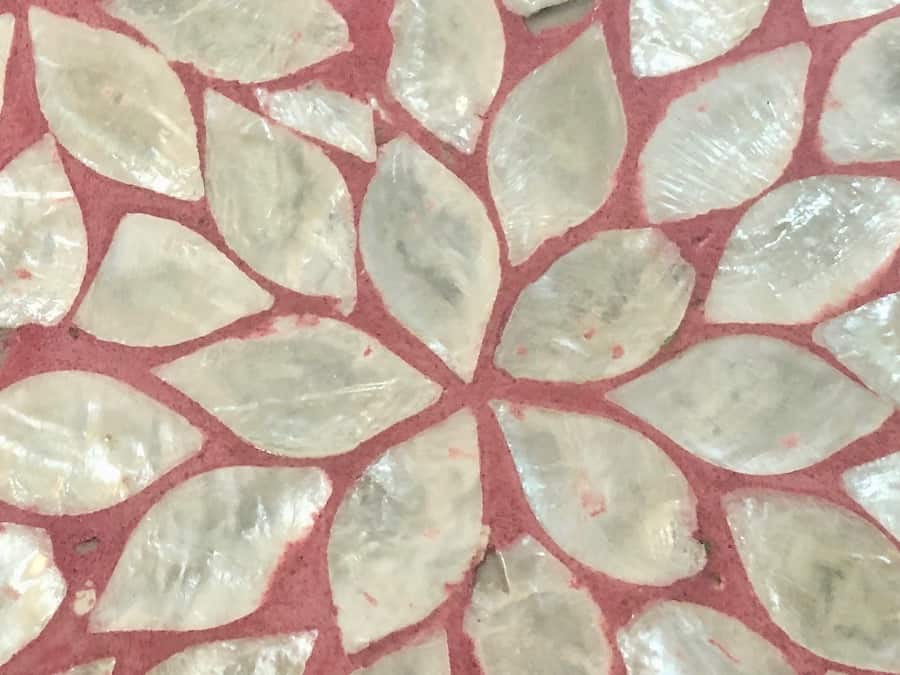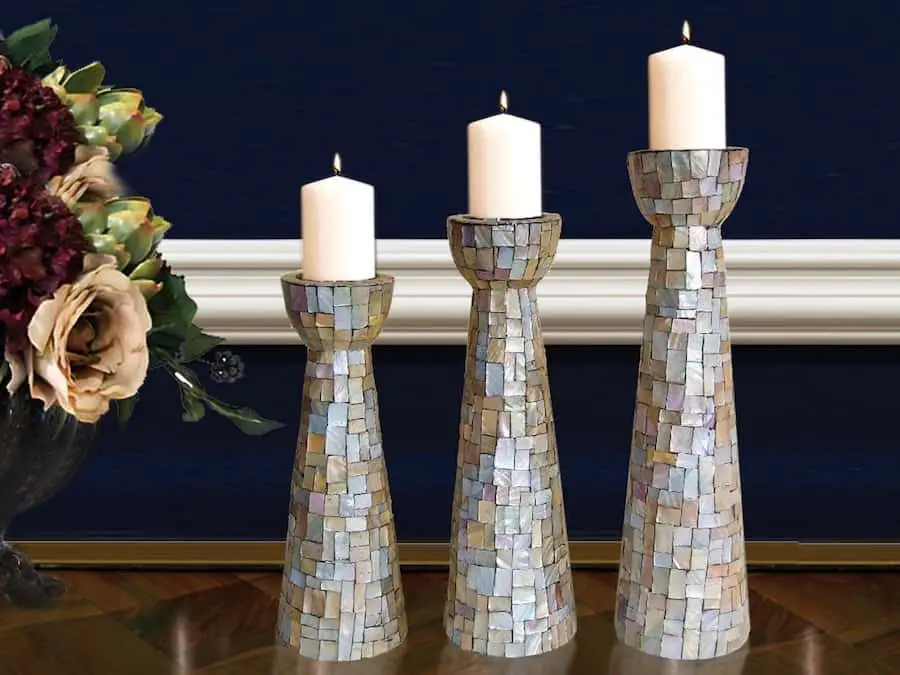Today, many home decor and home furnishing products are produced using the natural material of mother of pearl. The production of the mother of pearl products has a long and rich history in many places, including in Vietnam.
Mother of pearl, which is also known by the scientific name of nacre, is a pearl layer on the inner layer of the oyster shell. This pearl layer of the oyster is taken off the outer oyster shell. Then, the leftover inner pearl shell is cut into various small shapes and sizes to be then glued onto multiple home decor products such as mirrors, boxes, trays, and lamp bases.
Table of Contents
- Video: Tour Of Mother Of Pearl Factory
- What Is The Mother of Pearl Shell?
- What Is Vietnam’s History Of The Mother of Pearl Production?
- Where Does The Mother of Pearl Shells Come From?
- How Are The Small Shells Cut?
- Is Every Piece Of Mother of Pearl Really Put On By Hand?
- What Are The Colors Of Mother of Pearl?
- What Are The Best Ways To Use The Mother of Pearl On Products?
- The Lesson Learned: Why You Need a Fish and Wildlife License to Import Mother of Pearl into the United States
- Frequently Asked Questions
- Related Questions
Video: Tour Of Mother Of Pearl Factory
Here is a video about how the Mother of Pearl pieces is placed onto a product. You can see how every single piece must be placed by hand.
When a person purchases a mother-of-pearl box or tray or another home furnishing or decor item, it is truly a work of art. It can be said that the mother of pearl material is a gift from the ocean or river beds for us to use to decorate our homes.
What Is The Mother of Pearl Shell?
The mother-of-pearl shell is a beautiful natural material used for various products. What t is also amazing about this material is its natural properties that make it beautiful and durable.
The mother of pearl shell can best be described as the inner shell of the oyster. Some people call it the composite of nacre on the inner oyster shell. But whatever the scientific name, the inner oyster shells give a beautiful inner lining to the oyster shell.
What is interesting is that despite the mother of pearl being used for many centuries as a decorative element, scientists today do not understand how this beautiful yet durable inner pearl layer is formed inside the shell of an oyster.
They know that this inner shell that is formed and commonly known as the mother of pearl is hard and durable yet with natural beauty. And that for many years this pearl has been a special form of manufacturing decorative objects.

What Is Vietnam’s History Of The Mother of Pearl Production?
The mother of pearl items is produced in many parts of Asia. Still, the artisans considered experts in this kind of production are in Vietnam, especially in many handicraft villages in North Vietnam. We produce all our mother of pearl production in the villages in North Vietnam.
Vietnam has been producing the mother of pearl products for thousands of years. Traditional Vietnamese furniture uses the mother of pearl inlay in their furniture pieces. Many other traditional objects have also used the mother of pearl. Over the years, the mother of pearl production has become one of Vietnam’s top handicrafts manufacturing.

Where Does The Mother of Pearl Shells Come From?
The shell of the mother of pearl comes from both the ocean and the river. In Vietnam, this would be harvested from the South China Sea and the river beads around Vietnam.
The mother of pearl used in our products is produced in oysters, similar to that pearls are formed in an oyster. Natural pearls are so much more expensive than the mother of pearl shell because all oysters, whether in the river or ocean, will have some nacre coat or the mother of pearl on the inner lining of the shell, but not every oyster will form a natural pearl.
The forming of a pearl in the shell is essentially a reaction that the oyster has to something being in the shell, like a speck of sand or something else. That is why many places in the world that are harvesting pearls may put something in the shell to cause this irritation so that the pearl will be formed.
How Are The Small Shells Cut?
Before the mother of pearl can be cut into the required size or shape, the nacre layer, or the layer that we know as the mother of the pearl layer, must be taken off the back of the shell. This is usually done through an acid and sanding combination.
Once the layers have been separated, the pieces can be cut and polished into each shape used in the mother of pearl production.
Though some craftsmen may cut the mother of pearl pieces by hand, today, most of this production is done by precision machines. I have seen the mother of pearl suppliers come with their bags full of the mother of pearl, all polished and ready to be put on an object. Each large bag would hold a different shape of the mother of pearl.
So deciding on a new mother-of-pearl shape for a product means the mother of pearl material supplier needs to set up his machines to cut the unique shape for us. If and when they can cut a new shape will depend on the machines they have, and if the shape we require can be cut into mother of pearl.

Is Every Piece Of Mother of Pearl Really Put On By Hand?
The production of the mother of pearl products is extremely labor-intensive. Every single piece of the mother of pearl must be glued on by hand.
It must be glued on by hand, but it must be correctly. For example, every piece must line up and be highly straight and in the correct position if required. When you look at a mother-of-pearl item and see all the small pieces, you need to realize that every single small piece of the mother-of-pearl has required hand labor.
What Are The Colors Of Mother of Pearl?
The mother of pearl shells will naturally come in a variety of colors. Here are the primary colors of the mother-of-pearl shells:
- White – The white shell is one of the more common shells. Some of the white can almost have a golden tone to them.
- Pink – This is similar to a pink pearl, and the color of these shells is predominately pink.
- Abalone – Abalone color is the more difficult to find, so it can be the most expensive for the pearl mother, but it gives a lovely color combination.
- Dyed – Like we have dyed some horns, we can also dye the mother of pearl to some of the primary colors such as blue, red, orange, or green.

What Are The Best Ways To Use The Mother of Pearl On Products?
When looking to design or place the mother of pearl on a product, there are a few rules that should be remembered:
- Mother of Pearl Is A Natural Material – Mother of pearl is a natural material. Because it is a natural material, there will be variations in the product itself. This means that not every white piece will be 100% white, or every pink piece will be the same color. We try to match up the colors as much as possible for our products, but the mother of pearl is still a natural material.
- Larger Mother of Pearl Pieces Do Best On Flat Surfaces. – The more significant the mother-of-pearl piece, the better it is to secure it on a flat surface. The reason is that the mother-of-the-pearl piece is relatively flat. If the surface is round, you can still use the mother-of-pearl material, but the pieces should be smaller instead of the large pieces of mother-of-pearl.
- For A Higher-end Look In Mother of Pearl, Cover In Acrylic – One of the great things about Mother of Pearl products is that they are highly durable. The mother of pearl has properties that make it highly durable and withstand a lot of different things, even heat. We cover a lot of our mother of pearls in acrylic. This gives it a very lovely high-end look and a very smooth-looking finish.
This is also more expensive than just the regular mother of pearl as it has acrylic on it, but it is also a very nice, clean, and smooth finish. But for any acrylic topcoat, the surface must be flat like a box, a tray, or a square lamp base.

The mother of pearl is a very versatile yet natural product. It has some wonderful natural properties that make it very durable but also beautiful.
The Lesson Learned: Why You Need a Fish and Wildlife License to Import Mother of Pearl into the United States
The intricate beauty of Mother of Pearl has made it a sought-after material in various industries, from fashion to interior design. However, what many importers have learned the hard way, myself included, is that bringing Mother of Pearl into the United States requires more than just enthusiasm; it demands a Fish and Wildlife License.
Read on as we share our journey and the vital lesson we’ve learned about the necessity of this license to avoid the disappointment of having shipments returned. many importers have learned the hard way, myself included,
The Allure of Mother of Pearl
Mother of Pearl has been cherished for centuries with its iridescent hues and timeless appeal. Its versatility has made it a prized material for jewelry, decor, musical instruments, and beyond. Its rarity and unique properties have led many to seek it for their creations.
The Unpleasant Surprise And Fish And Wildlife License Requirement
Our initial excitement about importing Mother of Pearl quickly turned into a challenge when our shipments were unexpectedly returned. We soon discovered that the United States Fish and Wildlife Service (USFWS) tightly regulates the importation of Mother of Pearl under the Endangered Species Act.
The Role of the Fish and Wildlife License
The Fish and Wildlife License, specifically the USFWS Wildlife Import/Export License, is crucial for anyone looking to import Mother of Pearl into the United States. This license grants permission to import and export regulated wildlife, including Mother of Pearl.
Our Learning Curve
Our experience taught us that it’s not enough to be aware of the regulations; one must proactively apply for a Fish and Wildlife License before attempting any Mother of Pearl imports. The process involves detailed paperwork, fees, and a commitment to complying with USFWS guidelines.
The Consequences of Non-Compliance
Having shipments returned due to the lack of a Fish and Wildlife License can be costly, time-consuming, and frustrating. Non-compliance may also result in fines and legal repercussions, making it imperative to adhere to the regulations.
The Benefits of Compliance
Obtaining a Fish and Wildlife License isn’t just about avoiding penalties; it’s a commitment to ethical sourcing and responsible trade. It ensures that the Mother of Pearl you import adheres to conservation standards and helps protect endangered species.
Importing Mother of Pearl into the United States offers endless creative possibilities, but it comes with a responsibility to navigate the regulatory landscape. Our journey taught us the importance of the Fish and Wildlife License, a vital step in ensuring our passion for Mother of Pearl aligns with legal and ethical standards.
By obtaining the necessary license, we not only avoid setbacks but also contribute to the preservation of this remarkable material for generations to come.
Frequently Asked Questions
What’s the distinction between a pearl and mother of pearl?
Both a pearl and a mother of pearl are products of oysters, originating from the oyster’s shell. The key difference lies in their formation. A pearl forms when a foreign object, such as a speck of sand, irritates the oyster, prompting it to create a round case around the foreign object, resulting in a natural pearl. Mother of pearl, on the other hand, is the material found on the inner shell of the oyster itself.
How can you determine if mother-of-pearl material is genuine?
It can be challenging to ascertain the authenticity of the mother of pearl once it’s incorporated into an object. However, the genuine mother of pearl is difficult to replicate in plastic due to its iridescent properties. The most reliable way to confirm the authenticity of the mother of pearl is to examine the material closely. Authentic mother of pearl will exhibit slight variations in color and texture since it’s a natural material.
Are abalone shells the same as mother-of-pearl shells?
Abalone shells fall under the category of mother-of-pearl shells, as the manufacturing process for abalone shells in home decor products is identical to that of mother-of-pearl shells. The shells are cut, glued, and treated in the same manner. The primary distinction lies in the species; abalone shells appear slightly different. Unlike mother-of-pearl shells, abalone shells do not commonly produce pearls within their shells.
Find out more about how Mondoro can help you create, develop, and manufacture excellent home decor and home furniture products – don’t hesitate to contact me, Anita. Check out my email by clicking here, or become a part of our community and join our newsletter by clicking here.
Mondoro gives out a FREE Lookbook to anyone interested. You can receive a copy of our latest Lookbook by clicking here.
Listen to our Podcast called Global Trade Gal. You can find it on all major podcast platforms. Try out to listen to one of our podcasts by clicking here.
Subscribe to our Mondoro Company Limited YouTube Channel filled with great videos and information by clicking here.
Related Questions
The Tre Natural Color Trend for Home Decor and Home Furniture
Tre means bamboo. But it also helps to symbolize the strength and ability to be resilient. The Tre trend concerns nature as part of your life and home. The Tre natural color palette has a lot of lush green tones. The Tre trend can be used with other home decor and furniture trends.
You can discover more by reading The Tre Natural Color Trend for Home Decor and Home Furniture by clicking here.
Can Cane Furniture Be Left Outside?
Cane furniture is not outdoor weather-resistant; manufacturers produce outdoor weather-resistant furniture from synthetic, not natural, cane materials. Throughout history, cane furniture was in outdoor settings in many parts of the world; during that time, there was no genuinely outdoor weather-resistant furniture.
You can learn more by reading Can Cane Furniture Be Left Outside? by clicking here.
What Is The Difference Between Rattan, Wicker, And Cane Furniture?
Rattan is a type of palm or vine that grows in the jungles of Southeast Asia. Rattan refers to a kind of natural material. Wicker is a type of weave using rattan materials. Cane also refers to a type of weave that is usually woven using rattan material.
You can learn more by reading our blog What Is The Difference Between Rattan, Wicker, And Cane Furniture? by clicking here.


